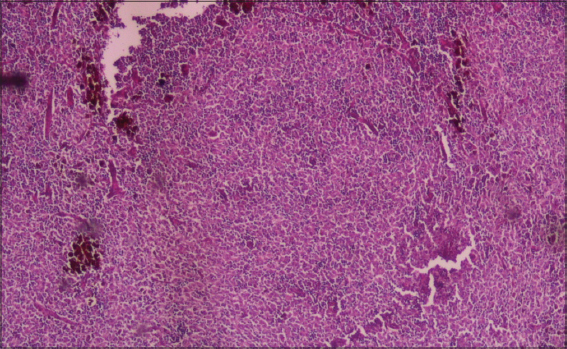Pautrier-Woringer disease: lipomelanotic reticulosis/dermatopathic lymphadenitis
Olfa El Amine El Hadj, Leila Bouhajja, Aida Goucha, Wafa Rekik, Ahmed El May, Amor Gamoudi
Immuno-Histo-Cytological Department, Salah Azaiez Institute Tunis, Boulevard 9 Avril, Bab Saadoun 1006 Tunis, Tunisia
Corresponding author: Dr. Olfa El Amine El Hadj, E-mail: olfaelamine@yahoo.fr
Submission: 10.03.2016; Acceptance: 05.06.2016
DOI: 10.7241/ourd.20171.26
Sir,
We report a 62 year-old woman with a 20-year’s history of extensive psoriasis, and thyroidectomy, presented with a 3-month history of multiple hypertrophied axillary lymph nodes. At first the diagnosis of metastatic breast cancer was suggested. Physical examination revealed a 2cm, firm and slightly mobile axillary lymph node. A cutaneous diffuse psoriasis was observed on the chest and upper limbs. The breast mammography showed foci of microcalcifications (ACR3) in the right breast, and bilateral axillary lymphadenopathies. The cervical and abdominal ultrasonographies were normal. A surgical resection of the axillary mass was performed. Grossly, the lymph node measured 2,5cm in size, had a soft consistency with black pigment on the cut. Histological examination showed large melanin granules in intra and extra cytoplasmic cells (Fig. 1). Paracortical and interfollicular spaces were colonized by a proliferation of histiocytes and interdigitating cells with elongated shape nuclei (Fig. 2). They were organized in very large nodules. Immunohistochemical evaluation showed intense and diffuse expression of S-100 protein and CD1a attesting of the interdigiting nature of cell proliferation. On the other hand, the cytokeratin antibody was negative. The patient received medical treatment, no other lymph nodes was found. These features confirmed the diagnosis of Dermatopathic lymphadenitis. At 3 years of follow-up, the patient was asymptomatic and there was no recurrence.
Dermatopathic lymphadenitis (DL) also known as lipomelanotic reticulosis or Pautrier-Woringer disease, represents a rare form of benign lymphatic hyperplasia associated with most exfoliative or eczematoid inflammatory erythrodermas, including pemphigus, psoriasis, eczema, neurodermatitis, and atrophia senilis. It involves the axillary, inguinal and cervical regions [1–3]. These Lymph nodes are moderately enlarged, firm, movable, and rather painless [4]. Diagnosis of DL is mostly based on the lymph node biopsy [5]. The differencial diagnosis includes anthracosis, melanoma metastasis and mycosis fungoides. DL is a benign process and management of these patients consists in simple clinical, mammographic and ultrasonographic follow-up [6].
Dermatopathic lymphadenitis is a benign lymphatic hyperplasia, histologically usually mimicking lymphoma. Immunohistological exam is of great apport for differential diagnosis.
Consent
The examination of the patient was conducted according to the Declaration of Helsinki principles. Written informed consent was obtained from the patient for publication of this article.
The patient’s informed consent was obtained.
Prior to the study, patient gave written consent to the examination and biopsy after having been informed about the procedure.
REFERENCES
1. Makis W, Hickeson M, Blumenkrantz M, Dermatopathic LymphadenitisA Pitfall for Lymphoma Evaluation by F-18 FDG PET/CTClin Nucl Med 2010; 35: 872-4.
2. Acipayam C, Kupeli S, Sezgin G, Acikalin A, Ozkan A, Inan DA, Dermatopathic lymphadenitis associated with human papilloma virus infection and verruca vulgarisJ Pediatr Hematol Oncol 2014; 36: e231-3.
3. Steffen C, Frédéric Woringer:Pautrier-Woringer disease (lipomelanotic reticulosis/dermatopathic lymphadenitis)Am J Dermatopathol 2004; 26: 499-503.
4. Ioachim HL, Medeiros LJ, Dermatopathic lymphadenopathy. Ioachim’s Lymph Node Pathology 2009; Philadelphia: Lipincott Company; 223-6.
5. Hu N, Tan YL, Cheng Z, Wang YH, Dermatopathic LymphadenitisChin Med J 2015; 128: 3121-2.
6. Rocco N, Della Corte GA, Rispoli C, Sabatino V, Romano F, Altiero M, Axillary masses in a woman with a history of breast cancer:dermatopathic lymphadenopathyInt J Surg 2014; 12: S40-3.
Notes
Source of Support: Nil
Conflict of Interest: None declared.


Comments are closed.